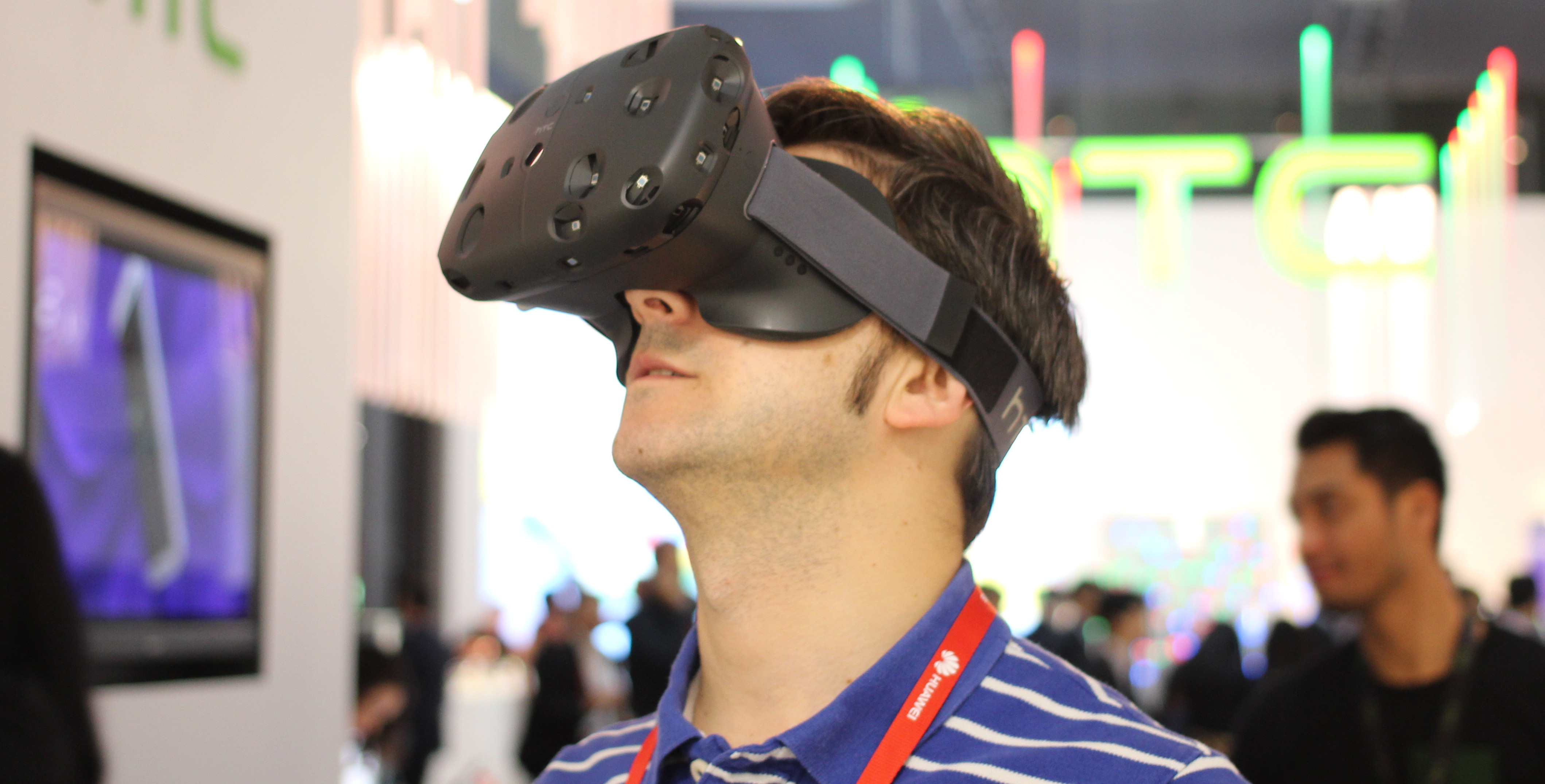 In wearables entertainment, this is expected to be a breakout year for Virtual Reality/Augmented Reality (VR/AR) headsets and a boon to retailers. This category is about enhancing the user experience during entertainment activities. These can include devices that receive and transmit real-time information to enhance the gaming experience and new ways to watch movies or other media and sales potential extends to other opportunities in dealers’ communities, such as for education and training.
In wearables entertainment, this is expected to be a breakout year for Virtual Reality/Augmented Reality (VR/AR) headsets and a boon to retailers. This category is about enhancing the user experience during entertainment activities. These can include devices that receive and transmit real-time information to enhance the gaming experience and new ways to watch movies or other media and sales potential extends to other opportunities in dealers’ communities, such as for education and training.
Oculus Rift had a big showcase at CES 2016. Retailers need to pay attention to Oculus and its strategic partners because they will be a driving force in 2016.
This year’s CES 2016 honorees in the Wearables category include:
- Samsung Gear VR This was redesigned for use with the entire 2015 flagship line of Samsung phones. It provides an intuitive, fully untethered experience with an extensive immersive content library.
- ODG R-7 Smartglasses These feature stunning, ultra-transparent 3D stereoscopic displays and are packed with innovative technologies in a small, light and sleek design. R-7 Smartglasses are fully integrated, with remarkable display clarity, onboard processing power and system accuracy.
- Vuzix’s M3000 Smart Glasses These are a hands-free personal communications system with Vuzix’s ultra-thin “waveguide-based” see-through optics. Using advanced AR technology, the M3000 Smart Glasses will connect cloud-based information to the real world.
- Vuzix’s Vidwear This product is about fashion meeting wearable display. It is sunglasses with integrated video and AR overlays. Fashion, style, augmented reality and 3D high-definition video commingle in a pair of sunglasses for on-the-go use.
Problem-Solvers for Improved Living
There are already as many as 50,000 apps tracking sleep, steps, calories and other health or fitness data, according to a PwC report. We expect this to be a hot category as people turn to these devices to sleep better or manage an illness or chronic condition.
PwC concluded that wearables have applications for consumers and for “healthcare organizations to improve care and potentially reduce costs through systems such as remote patient monitoring.” We would also suggest that insurance companies and local companies are starting to consider preventive care and care management, using certain devices like Fitbit products.
Accordingly, channels need to research local opportunities, whether with corporations, insurance companies, assisted living facilities or other venues. For instance, as corporations offer high-deductible health plans, people may be increasingly motivated to track their health indicators. This is about opportunities in the wearables and wellness or health market, in terms of devices or peripherals that solve a genuine problem or add real convenience. These products are now finding their way onto store shelves, whether at Walgreens, CVS, Target or at Best Buy, and at other retailers.
According to PwC, changing consumer behavior evolves around being able to monitor one’s own health better. Perhaps individuals can cut some of their own costs in the long run, and insurance companies are experimenting with them as a way to encourage their members to have healthier habits, according to their findings. This certainly makes for a great sales pitch!
In the CES 2016 Honoree Fitness/Sports Category, products that caught our attention were:
- SleepPhones Harmony Who doesn’t have problems sleeping? Imagine the opportunity! These headphones-in-a-headband combine ultra-comfortable, remarkably thin wireless music headphones with state-of-the-art sleep sensors and a real-time intelligent music app for a good night’s sleep.
- Veta Smart Case and App for EpiPen This is among the world’s first anaphylaxis and food allergy support systems. Veta Smart Case for EpiPen and its mobile app work together to connect loved ones to people living with life-threatening allergies, offering peace of mind for everyone involved.
- MyECG is a pocket, wireless intelligent connected device that allows for a quick and easy record of an electrocardiogram. Connected to a smartphone via Bluetooth 4.0 LE and the application BewellConnect, the user will obtain an interpretation of the data and recommendations.
- QardioBase is a wireless smart scale and body analyzer that combines intelligent features, ease of use, and sleek design to make weight and health management an integral part of everyday life. It provides a deeper view of health by measuring weight, body mass index, and full body composition.
- Skulpt Chisel measures body fat percentage and the quality of up to 24 different muscles on the body. Measurements sync via Bluetooth Smart to a mobile app for users to track their progress, and see their strongest areas or those that need improvement.
- TempTraq was recognized twice, once in the Fitness Category and also in Wearables. It is a single-use, wearable, Bluetooth thermometer in the form of a soft, comfortable patch. It’s designed to ease parents’ worries by continuously monitoring body temperature for 24 hours through a specially designed, free downloadable iOS- or Android-compatible app.
- Mint claims to be the world’s first portable oral healthcare product that monitors breath quality and hydration levels. Simply place Mint in your mouth, let it automatically draw a sample of air, and within seconds, the Breathometer app will report back on your oral hygiene. This might appeal to the self-quantified crowd.
- LifeFuels Smart Nutrition Bottle is a portable “smart bottle” that stores, suggests, dispenses and tracks daily nutrition by creating custom drinks from an innovative dispensing unit integrated into the lid. When used with activity trackers, it correlates intake to performance.
- OURA is a ring-sized wellness wearable computer and app. It helps one get more restful sleep and adjust one’s daily activities towards better balance and performance. With this ergonomic ring, says the company, one will learn when to challenge oneself and when to rest.
In terms of greater context, products like the Apple Watch or Samsung Gear enhance the consumer’s lifestyle or workstyle experience and also supply data based on the consumer’s behavior, usually through an accompanying application. Given the demand for these products, a slew of accessories is also coming to market.
More Areas to Watch
But there’s even more opportunity for retailers. Here are just a few more areas to watch:
Medical. This is the next step, and it’s viewed as a high-growth area at retail, as more devices come into the market that monitor vital signs and medical data, and where wearable technology can be implemented to understand and treat patients’ conditions. McKinsey forecasts that $2 trillion could be saved worldwide by 2025 with a 10-to-20-percent cut in the cost of treating chronic diseases through using mobile sensors. The HIS (Health Systems and Innovation) branch of the World Health Organization further estimates that five million patients will be using wearable technology and remote monitoring by 2017 worldwide.
Pets/Animals. This is a huge market, because people are very attached to their pets. There are devices that connect pets with their owners via a sensor worn by the animal and a mobile app that displays and interprets the data from the sensor. Whistle, for example ($99), is a wearable device for dogs that tracks their activities and location via a sensor that attaches to the dog’s collar. The device has wireless connectivity that communicates with the Whistle mobile app to help ensure that the user’s dog won’t be lost. Whistle provides information on the dog’s everyday health and monitors activity levels.
Other devices track a pet’s medication, activity level, or food monitoring.
Industrial or Enterprise Wearable Devices. These are here, and they are designed to that transmit and receive real-time data in work environments. Look around your community and identify opportunities whether it be in logistics, energy, oil and gas or healthcare. According to ABI research, the market for enterprise wearable technology will balloon over the next three years at an annual growth rate of 56.1 percent, reaching a market size of $12.2 billion by 2018.
One example of this category of product is the AiRScouter, a wearable head-mounted display. It projects images in front of the user’s eye on the lens of the glasses. The device is built for industrial purposes — specifically, device assembly and remote operation support. The technology’s assembly support allows the user to access the information necessary to assemble complex devices. The remote operation support allows the user to receive audio and video instruction from off-site specialists.

